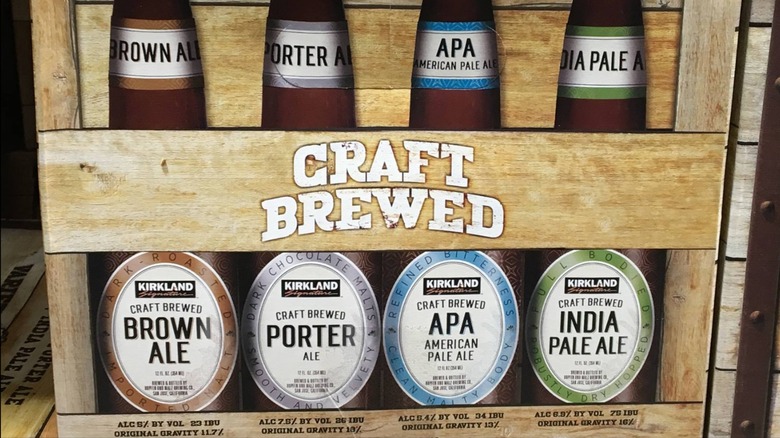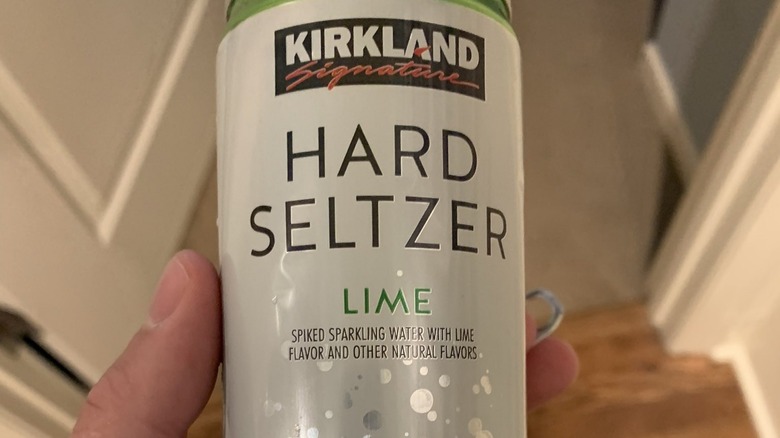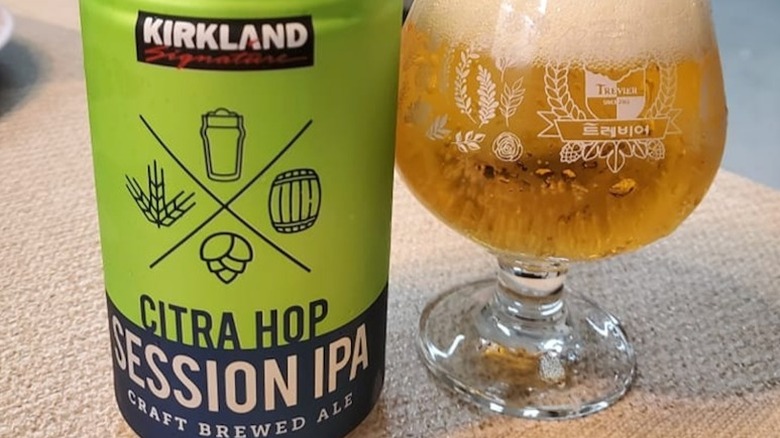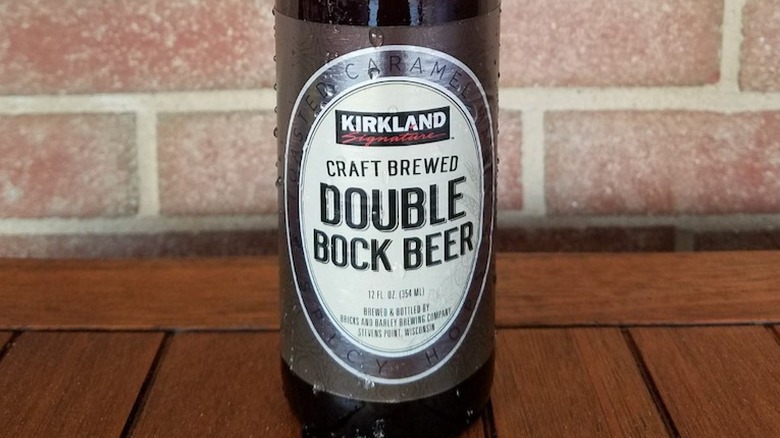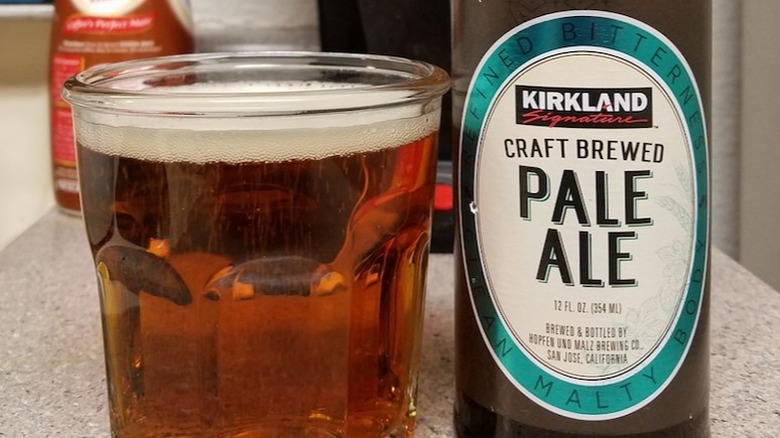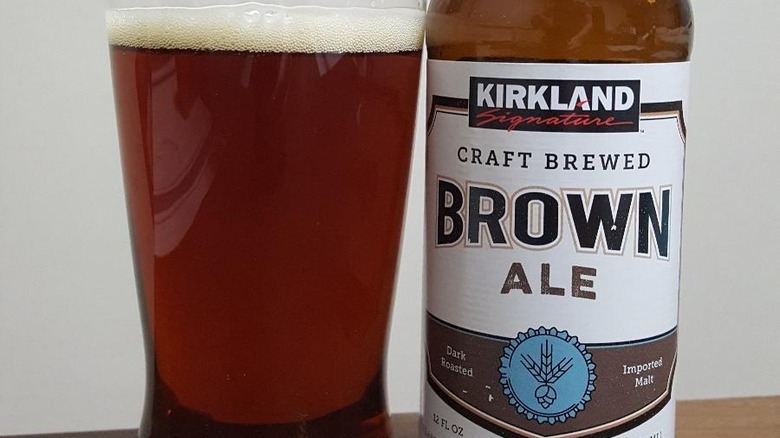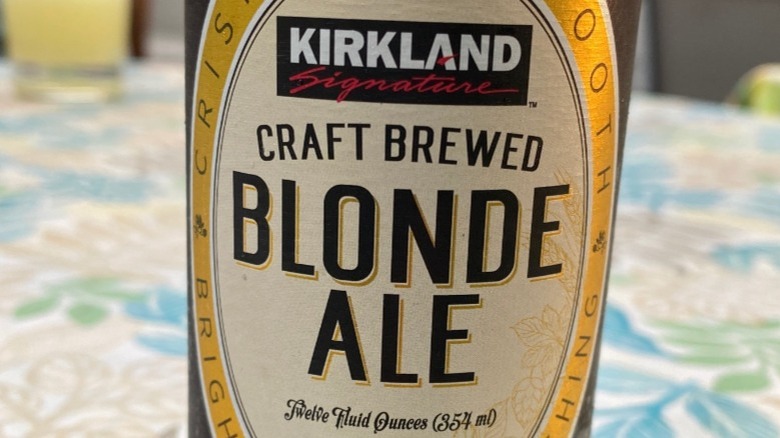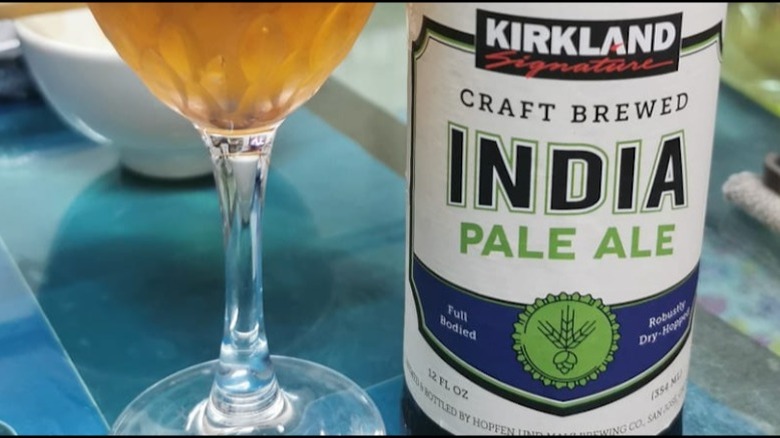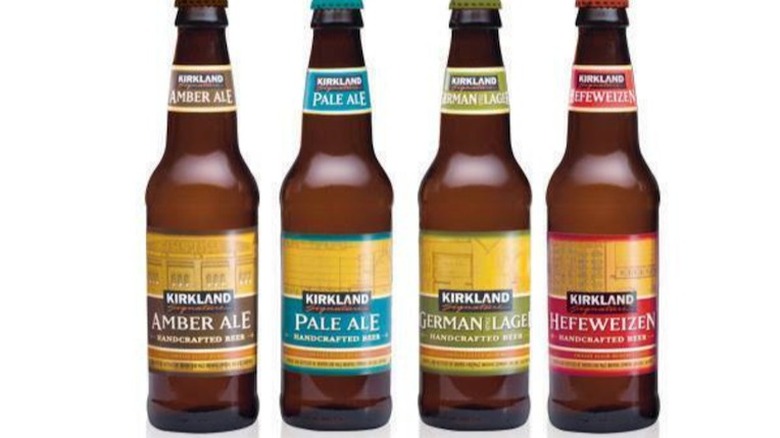The Ultimate Guide To Kirkland Beer
One of the perks of shopping at Costco — besides getting the opportunity to nosh on free samples while you pick up your bulk items — is the availability of their proprietary brand of Kirkland Signature items. Introduced in 1995, the signature brand was named after the location of the corporate headquarters for Costco, Kirkland, Washington (via CNN). The Kirkland line boasts about 30 products and is big business for the retailer, garnering $58 billion in profits in 2021.
The reason people love the Kirkland brand so much? On average these items sell for approximately 20% less than their brand-name versions. And while some store brand products are lower quality knock-offs of brand name items, many of Kirkland's offerings are actually brand name items incognito. Indeed, the cult-like following of certain Kirkland items is evidence of the fact that these products are good, really good. One such product is their line of Kirkland beers, which comes in a number of different varieties, including a popular sampler pack that gives consumers the opportunity to try several of their flavors. Many of their beers rank consistently highly in consumer reviews, but which ones should you try? That may be a matter of taste. Here's a round-up of their beers.
Kirkland Hard Seltzer
Kirkland Hard Seltzer is a carbonated, fermented, malt beverage similar in style to White Claw, Truly, and Bud Light Seltzer (via CraftJacks.com). The product was released in 2020 and is sold in a 24-pack variety case. Flavors include Black Cherry, Grapefruit, Lime, and Mango. Each can contains 5% ABV or percentage of alcohol by volume, 100 calories, and is gluten free. The beverage line is manufactured in Hood, Oregon by Patco Brands. Because Patco also manufactures Mystic Reef — which comes in the same exact flavors — there is some suspicion that they may actually be the same product, per Bartending Barista.
The primary appeal is how affordable these seltzers are. While prices may vary depending upon your location, they are priced well below their competitors, making them a great value if you are looking to stock up for a party. Reviews vary somewhat, however KodiakBlack23 is a fan: "Former White Claw purist/junkie here.. my gf brought a case of these home the other day and, HALLELUJAH!! They are BETTER than White Claws! The flavors just taste better and fresher, and they go down just as smooth, crisp and refreshing. And at $17.99 for a 24 pack, which is actually LESS than the price of a White Claw 12 pack, it's a no brainer! Just stocked up on 4 cases.. wallet happy.. liver, not so much" (via Reddit).
Kirkland Session IPA
Per Beer Pal, the Kirkland Session IPA is a highly drinkable, citrus-forward, hoppy beer with an alcohol content of 4.9% alcohol by volume (ABV). It differs from an IPA in a number of ways, per Anytime Ale. As a general rule of thumb, Session IPAs are lower in alcohol content than regular IPAs — less than 5% ABV on average as opposed to over 5% ABV. This is the key to why they are popular and how they got their name. During World War I, drinking during the workday was considered acceptable. In fact, London factory workers were given two drinking "sessions" during their shift, each one lasting two hours (via NPR). The key to their ability to both drink and work was the low alcohol content of the beers they were consuming. Session IPAs fit this bill by being flavorful and satiating without causing someone to get drunk. The rule of thumb was that you could consume 1-2 pints or ½-1 liter without hitting the deck (per Anytime Ale).
Most Session IPAs are less bitter and hoppy and tend to be lighter-bodied compared with regular IPAs. GordonBiersch notes on Beer Advocate, "Smooth tasting and amber color, moderately bitter and shallow aromatic. But at 1/3 less than other IPA's, this is solid, drinking beer that deserves to be a part of anyone's beer drinkers 'session'!" Again, the biggest pro to the Kirkland Session IPA is its value — a common theme with all of Kirkland's beer offerings.
Kirkland Double Bock
The Double Bock, or "doppelbock," is a style of beer that originated in the 17th century in the Bavarian stronghold of Munich, Germany (via Craft Beer & Brewing). Not unlike many early brews, this style of beer was introduced by monks residing at the convent in the village of Au. Known as "liquid bread," the potent full-bodied beverage was integral in helping the monks survive the days of fasting throughout Lent. These fermented lagers characteristically have a burnt sienna color, a bouquet evoking bread-pudding, and a flavor somewhat like a slightly hoppy malt ball.
According to contributors on Beer Advocate, the Kirkland Double Bock boasts an alcohol content of 7.5% ABV, a medium to full body, and a dark brown color. It has aromas replete with hints of caramel and peanut butter, and a sweet flavor profile abundant with a raisin and dried fruit aftertaste. To quote Brutaltruth on Beer Advocate, "Not a lot to hate about this one — decent and would have it again."
Kirkland Pale Ale
The American Pale Ale came onto the beer scene in the late 1970s, when the craft brew movement began taking off (via Craft Beer). Domestic versions of the pale ale pay homage to their British counterparts, which were born in the 18th century when malting technology became sophisticated enough to brew a more diverse-bodied beer. The American Pale Ale typically boasts a higher alcohol content than its British counterparts, is more malt-forward, higher in hops, uncharacteristically high in carbonation, and served far colder.
Kirkland's Signature Pale Ale, while classic in the sense that it is quite hoppy with a pale color and malt-forward body, diverges from other American Pale Ales with its distinct herbal citrus flavor (via Untappd). Its alcohol content is moderate at 5.4% ABV, and like other Kirkland brands, its value is incomparable. A review by KMillard on Beer Advocate reads "Average non offensive Sierra style pale ale. A good value for less than a dollar a bottle. I think the best in the Kirkland bricks and brews made variety pack, which would be good for a low budget party micro selection."
Kirkland Brown Ale
Like the pale ale, brown ales evolved in Britain around 1817, when Daniel Wheeler invented the drum malt roaster, per Anchor Brewing. This style of roaster enabled brewers to tailor the color of their beers, expanding them beyond porters and stouts to include black and brown beers. Their introduction to the U.S. began predominantly in the privacy of the dwellings of homebrewers — specifically among homebrewers in Texas who enjoyed tinkering with and adapting the historic British recipes for brown ales into their own unique blends. These all-malt variations tended to be stronger in hops and higher in alcohol than their British counterparts.
According to Untappd, the Kirkland varietal of brown ale is produced using eight distinct malts which yield a complex nut, molasses, and malt palate. At 5% ABV, its moderate alcohol content makes it highly drinkable. While reviews on Beer Advocate are mixed, with some saying it has a body more like an amber or pale ale, yet again the price would be hard to beat. If authenticity and faithfulness to a true brown ale aren't dealbreakers, it's a great option.
Kirkland Blonde Ale
According to Kegerator, the blonde ale likely evolved in the late 1800s from combining a British pale ale with a Kölsch. Often called a "summer ale" thanks to its light body and refreshingly ideal carbonation, a true blonde ale cannot be identified by the color of the beer alone. While most tend to have a light amber color, their color may vary widely. These beers typically have a moderate amount of fruitiness combined with light hops and malt content. Alcohol content ranges on average from 3.8-5.5% ABV, making it highly variable from one brewer to the next (via Kegerator).
Kirkland's Blonde Ale falls right in the middle of the range with an ABV of 4.3% (via Beer Advocate). Its color is consistently referred to as "golden straw" and its flavor is both fruity and bready. Several critics noted that it seems a bit watered down in texture but has a pleasant level of carbonation, making it a great option for a hot summer day. All in all — the reviews suggest that it is a blonde ale consistent with what is considered to be standard, making it a decent choice for a summer barbecue or pool party.
Kirkland India Pale Ale
The world of IPAs, or India Pale Ales, is incredibly diverse (via Allagash). While most people associate IPAs with excessive hops and bitterness, this isn't necessarily the case across the board. Terminology is important in deciphering what you are getting where IPAs are concerned. Session IPAs have a lower alcohol content — typically below 5% ABV. Double or Imperial IPAs tend to have a higher alcohol content to tone down the hoppiness — generally above 7% ABV. Dry-Hopped refers to adding the hops directly to the fermenting beer as opposed to incorporating it into the boiling process, which mitigates the bitterness. Single-Hopped indicates that only one type of hop was added to the beer as opposed to a variety of different hops. And Fresh or Wet-hopped denotes beer where the hops went straight from harvest into the beer production within 24 hours (via Bon Appétit).
Further distinctions are made using style classifications, each of which point to a particular recipe that creates a specific flavor, mouthfeel, and appearance. These include British, West Coast, East Coast, New England, Oat, Lactose or "Milkshake," Belgian, Fruited, Sour, and Brett. Ultimately the aggressive presence of hoppiness is what tends to make an IPA desirable. As far as the Kirkland IPA is concerned, it is considered "hop-centric" and filled with citrusy flavors including grapefruit, with an alcohol concentration of 6.9% ABV (via Untappd). Ratings are fairly average, but if you like slightly bitter, hoppy IPAs, this is a great value.
Where is Kirkland beer made?
What may surprise many Kirkland beer consumers is that their signature beer collection is actually produced by rather well-known beer manufacturers. Beer sold on the West Coast of the U.S. is brewed by Hopfen Und Malz Brewing Co., located in San Jose, California. Some may be more familiar with their other name, Gordon Biersch, the craft brewery specializing in authentic German-style beers. East Coasters may note that their Kirkland brand beers have been produced by Bricks and Barley Brewing Company of Steven's Point, Wisconsin. According to USA Today, this brewery also manufactures beers under Roundy's Supermarkets brand name, which supplies markets in Wisconsin, Illinois, and Minnesota.
As noted in the Tampa Bay Times, Costco is hardly the only one utilizing bigger name breweries to produce their products which are subsequently rebranded. In fact, Trader Joe's does exactly the same thing. So before you discount these value-priced beer options, it's worth considering that you are actually getting decent beer at a much more affordable price.
